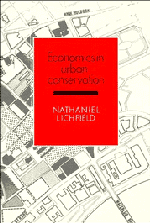Book contents
- Frontmatter
- Contents
- List of diagrams, tables and plans
- Preface
- Acknowledgements
- Introduction
- Part I Planning and management in the conservation of the urban system
- 1 Life cycle in the urban system
- 2 Planning and management of urban resources
- 3 Planning for urban conservation
- Part II Conservation of the cultural built heritage
- Part III Economics in urban conservation
- Part IV Selected tools of economic analysis for project evaluation
- Part V Case studies in the economics of conservation of the CBH
- Notes
- Bibliography
- Index
2 - Planning and management of urban resources
Published online by Cambridge University Press: 10 November 2010
- Frontmatter
- Contents
- List of diagrams, tables and plans
- Preface
- Acknowledgements
- Introduction
- Part I Planning and management in the conservation of the urban system
- 1 Life cycle in the urban system
- 2 Planning and management of urban resources
- 3 Planning for urban conservation
- Part II Conservation of the cultural built heritage
- Part III Economics in urban conservation
- Part IV Selected tools of economic analysis for project evaluation
- Part V Case studies in the economics of conservation of the CBH
- Notes
- Bibliography
- Index
Summary
From resource to property and commodity
Overview
The preceding chapter introduced the urban system as a resource (1.3). but it was found from the earliest days of settled cultivation that for their potential to be realised the resources in production and consumption must be appropriated into ownership by particular individuals or bodies. Producers must own their means of production to provide incentives and security for output; consumers must own their purchase of the output; the ownership must therefore be protected under the law, for otherwise there would be a general loss of liberty, freedom and welfare. Thus while in common parlance property is the real object which is possessed or owned, it cannot be ‘… defined as something apart from those relationships which in juridical thought give a thing, a benefit or a privilege the status and quality of property’. In this book we use the term property to mean both the real thing and also the property relationships. Thus resources potentially have use value (1.3). When they become property, and as property are available for exchange as commodities, they may have exchange value. Typically this applies to the first two categories of natural resources described above (1.4.1) (exhaustible but renewable or non-renewable) and also to man-made resources (1.4.3). But all the while they are free goods (i.e. accessible to all without payment) it has not been practicable to appropriate the non-exhaustible resources (sun, air, rain and climate).
- Type
- Chapter
- Information
- Economics in Urban Conservation , pp. 35 - 49Publisher: Cambridge University PressPrint publication year: 1989



